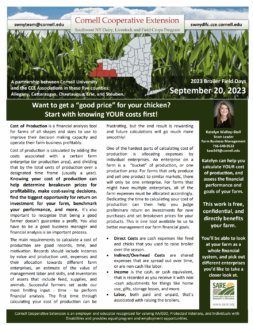This set of publications were developed by Cornell University and are intended to help producers of slow-growth and conventional broilers understand their costs of production and track the performance of their flocks. A third fact sheet shares guidance on breaking down a carcass into desired cuts.
Calculating Costs of Production
Farmers must figure out their costs of production in order to charge a price for their chicken that will break even or turn a profit. In addition, this information helps farmers make cost-savings decisions and find ways to improve their return on investment. This worksheet takes the reader through a simple cost-of-production tracking spreadsheet.
Track Broiler Flock Performance
The published values for broiler flock efficiency that many producers follow to determine their costs of production are those shared by commercial production guides, which raise broiler chickens in climate controlled facilities with finely tuned water and feed programs. In a pasture-raised scenario, the variable conditions in weather, temperature, predation, breed, and feed mean that efficiency is going to vary from flock to flock. Instead of relying on book values for performance, farms can use this fact sheet to evaluate their flocks' efficiency and fine tune their production practices to get the most from their flocks.
Poultry Carcass Breakdown
Breaking down whole carcasses into parts is a skill learned through practice, and it has the potential to increase on-farm income by providing customers with familiar, easy-to-cook pieces of chicken. Approaching the cuts from a safe and efficient perspective is key. This photo-heavy fact sheet shows the step-by-step process of breaking down a whole chicken.
Want more information? See the related SARE grant:
This material is based upon work that is supported by the National Institute of Food and Agriculture, U.S. Department of Agriculture through the Sustainable Agriculture Research and Education (SARE) program. Any opinions, findings, conclusions, or recommendations expressed in this publication are those of the author(s) and should not be construed to represent any official USDA or U.S. Government determination or policy.
